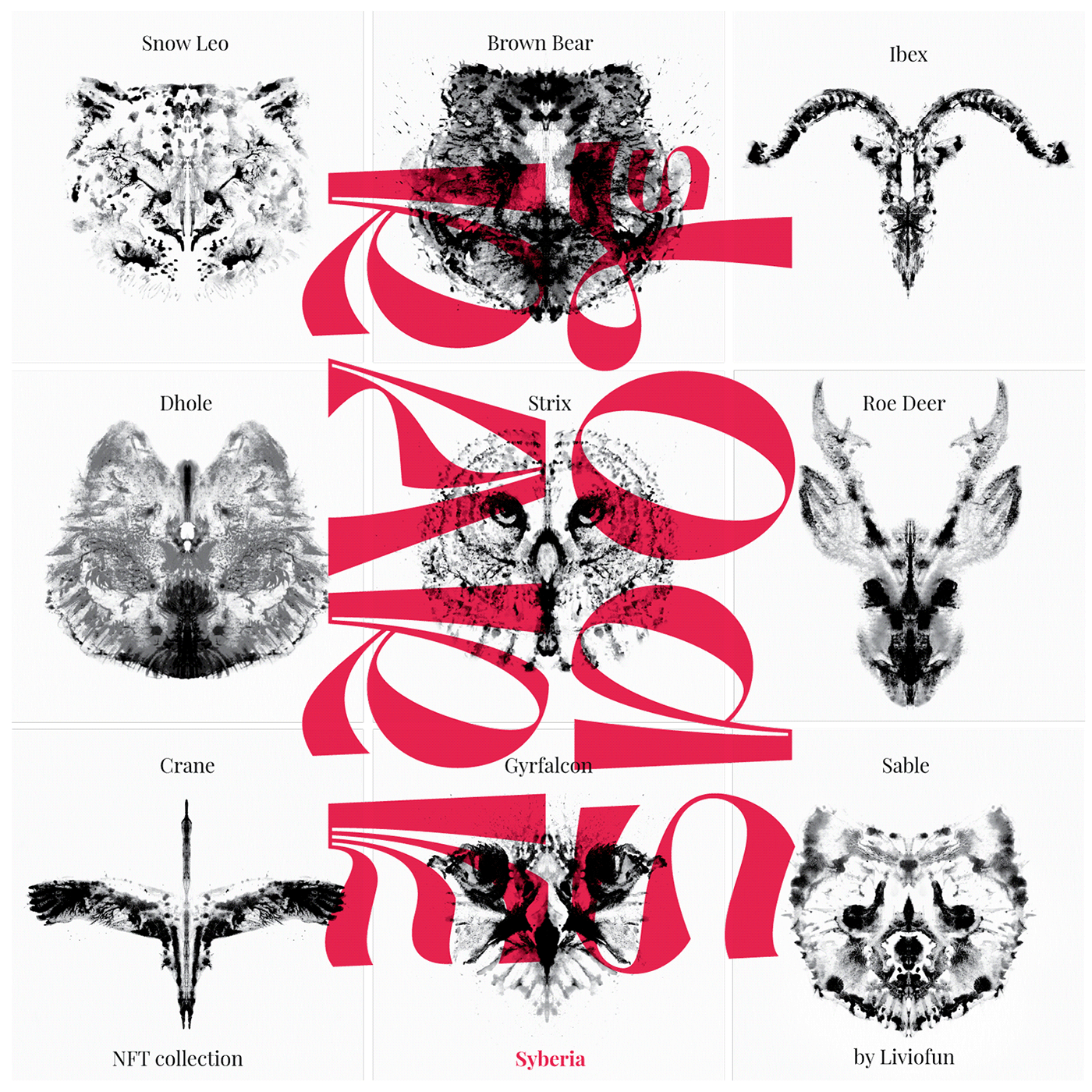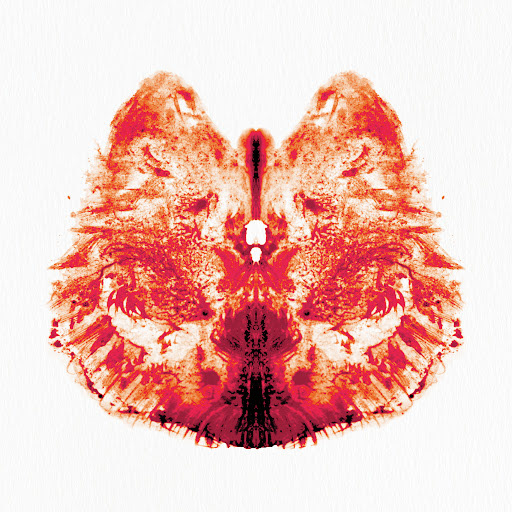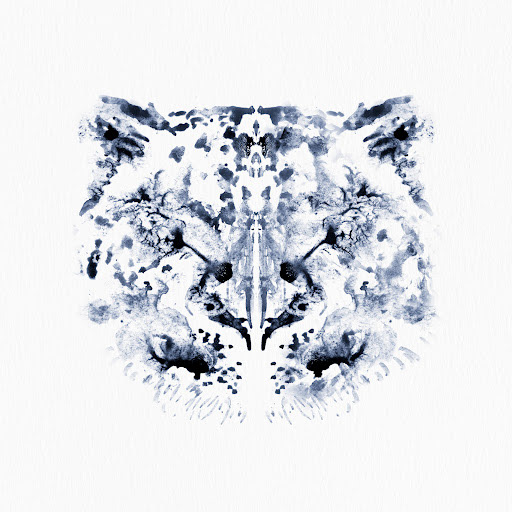

This is a collection of 1/1 rare spots: animals and birds that are disappearing
from Earth. Sometimes we no longer understand what they look like, and our consciousness tries to build a picture of their face, like an imprint of wildlife
in a Rorscharch spot. All spots are made using a mixed technique of analog painting and post-processing. A random print pattern is obtained by folding
a sheet of paper and wet paint.
from Earth. Sometimes we no longer understand what they look like, and our consciousness tries to build a picture of their face, like an imprint of wildlife
in a Rorscharch spot. All spots are made using a mixed technique of analog painting and post-processing. A random print pattern is obtained by folding
a sheet of paper and wet paint.
12
rarest animals from Siberia.
Check it: Rare Spots on Opensea.io

Red Wolf (Dhole)
The dhole (Cuon alpinus) is a canid native to Central, South, East, and Southeast Asia. Other English names for the species include Asian wild dog, Asiatic wild dog, Indian wild dog, whistling dog, red dog, and mountain wolf. It is genetically close to species within the genus Canis
It is listed as Endangered on the IUCN Red List, as populations are decreasing and estimated
to comprise fewer than 2,500 mature individuals. Factors contributing to this decline include habitat loss, loss of prey, competition with other species, persecution due to livestock predation,
and disease transfer from domestic dogs.
to comprise fewer than 2,500 mature individuals. Factors contributing to this decline include habitat loss, loss of prey, competition with other species, persecution due to livestock predation,
and disease transfer from domestic dogs.

Snow Leo
The snow leopard (Panthera uncia), is a feline of the genus Panthera, found in the mountain ranges
of Central and South Asia. It is listed on the IUCN Red List as vulnerable because the global population is estimated to be less than 10,000 mature individuals and is expected to decline by about 10% by 2040.
It is threatened by poaching and habitat destruction as a result of infrastructure development.
of Central and South Asia. It is listed on the IUCN Red List as vulnerable because the global population is estimated to be less than 10,000 mature individuals and is expected to decline by about 10% by 2040.
It is threatened by poaching and habitat destruction as a result of infrastructure development.

Great Owl
The Great Gray Owl is a very large owl, documented as the world's largest species of owl by length. It is distributed across the Northern Hemisphere, and it is the only species in the genus Strix found in both Eastern and Western Hemispheres. In some areas it is also called Phantom of the North, cinereous owl, spectral owl, Lapland owl, spruce owl, bearded owl, and sooty owl.
In EU, the breeding population is about 2,000 pairs. The deterioration of habitat through forest exploitation and disturbances are the major threats for the species.

Gyrfalcon
Gyrfalcon is the largest member of the falcon family. Gyrfalcons are common in the arctic and subarctic zones of Europe, as well as in Asia and North America. A separate subspecies lives in Altai and the Sayan Mountains.
Gyrfalcons are divided into white, Icelandic, Norwegian (ordinary "gray") and red. This bird is listed in the Red Book of the Russian Federation. Catching gyrfalcons in Russia is prohibited, as is the export of these rare birds abroad without special permission. According to experts, the population of gyrfalcons in Russia ranges from 5 to 14 thousand individuals, and in Kamchatka - from 1 to 1.5 thousand. According to ornithologists, the Northeast Asian population is especially affected by poachers.

Brown Bear
The brown bear (Ursus arctos) is a large bear species found across Eurasia and North America. It is one of the largest living terrestrial members of the order Carnivora, rivaled in size only by its closest relative, the polar bear (Ursus maritimus), which is much less variable in size and slightly bigger on average.The brown bear is recognized as a national and state animal in several European countries. While the brown bear's range has shrunk, and it has faced local extinctions across its wide range, it remains listed as a least concern species by the International Union for Conservation of Nature (IUCN) with a total estimated population in 2017 of 110,000.

Siberian Ibex
The Siberian ibex (Capra sibirica) is a species of ibex native to Central Asia. It is the longest and heaviest member of the Capra genus, although its height at the shoulders exceeds the markhor. This is a rare species whose population is declining. In the Red Book, the Siberian mountain goat is assigned category 3. It is interesting to note that its status was changed to a declining species only in 2020.

Siberian Roe Deer
The Siberian roe deer (Latin Capreólus pygárgus) is a cloven-hoofed animal of the deer family, related to the European roe deer.On the territory of the Tomsk region, the species is listed in the regional Red Book. Since 2012, two subpopulations of Siberian roe deer (Buzimo-Kantatsko-Kemskaya, Uluysko-Bogotolsko-Achinsk) have been listed in the Red Book of the Krasnoyarsk Territory with the status of steadily decreasing in the number of groups.

Siberian Crane
The Siberian white crane (Latin Grus leucogeranus) is a species of crane endemic to the northern territories of Russia. Sterches are endangered and are included in the international lists of the Red Book of the International Union for Conservation of Nature and the Convention on International Trade in Animals CITES, as well as the Red Book of Russia. Currently, the number of the Yakut population of the species (in the wild) is estimated at approximately 2900-3000 individuals. A critical situation has developed with the Western Siberian sturgeons — there are about 20 individuals left in nature.


Check it: Rare Spots on Opensea.io
